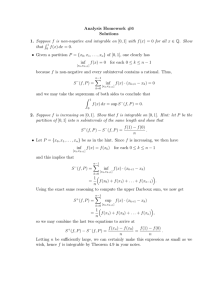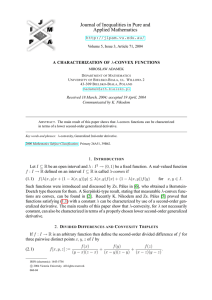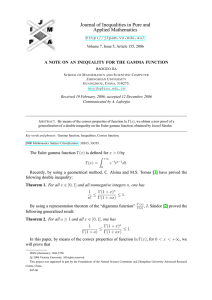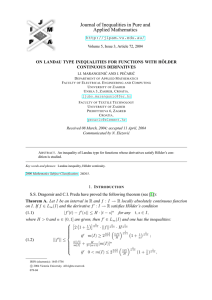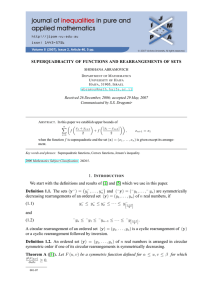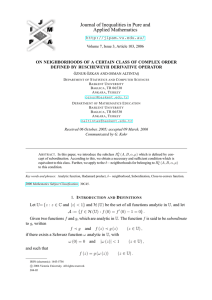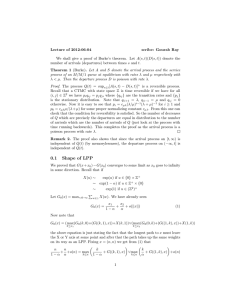INEQUALITIES IN THE COMPLEX PLANE Communicated by H.M. Srivastava
advertisement
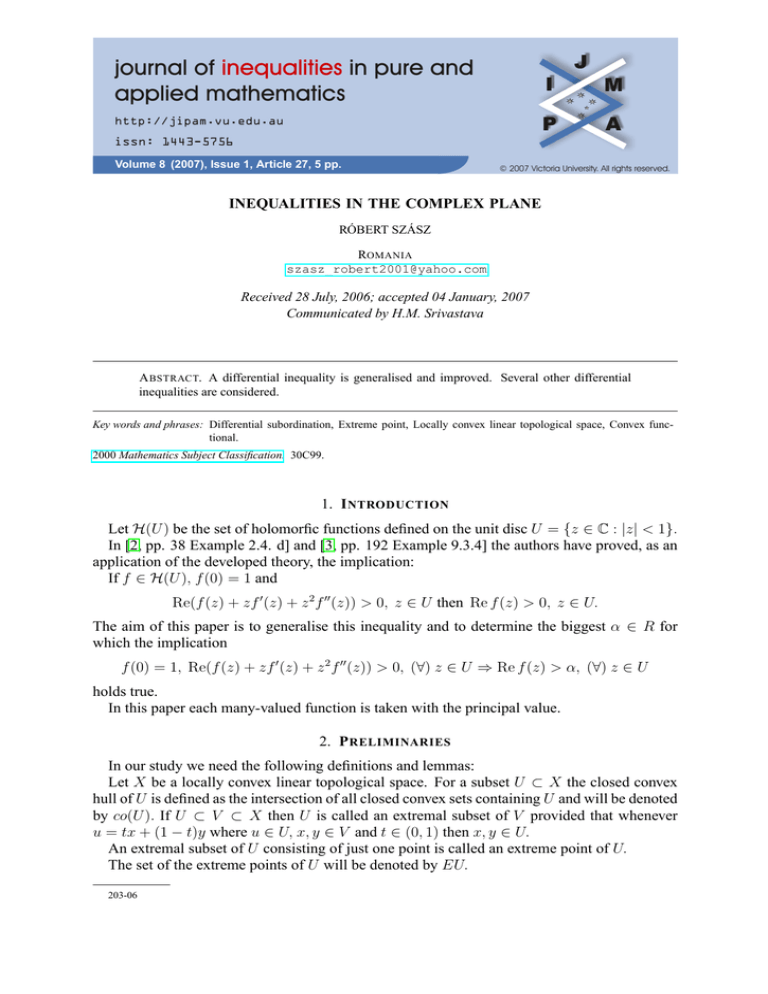
Volume 8 (2007), Issue 1, Article 27, 5 pp.
INEQUALITIES IN THE COMPLEX PLANE
RÓBERT SZÁSZ
ROMANIA
szasz_robert2001@yahoo.com
Received 28 July, 2006; accepted 04 January, 2007
Communicated by H.M. Srivastava
A BSTRACT. A differential inequality is generalised and improved. Several other differential
inequalities are considered.
Key words and phrases: Differential subordination, Extreme point, Locally convex linear topological space, Convex functional.
2000 Mathematics Subject Classification. 30C99.
1. I NTRODUCTION
Let H(U ) be the set of holomorfic functions defined on the unit disc U = {z ∈ C : |z| < 1}.
In [2, pp. 38 Example 2.4. d] and [3, pp. 192 Example 9.3.4] the authors have proved, as an
application of the developed theory, the implication:
If f ∈ H(U ), f (0) = 1 and
Re(f (z) + zf 0 (z) + z 2 f 00 (z)) > 0, z ∈ U then Re f (z) > 0, z ∈ U.
The aim of this paper is to generalise this inequality and to determine the biggest α ∈ R for
which the implication
f (0) = 1, Re(f (z) + zf 0 (z) + z 2 f 00 (z)) > 0, (∀) z ∈ U ⇒ Re f (z) > α, (∀) z ∈ U
holds true.
In this paper each many-valued function is taken with the principal value.
2. P RELIMINARIES
In our study we need the following definitions and lemmas:
Let X be a locally convex linear topological space. For a subset U ⊂ X the closed convex
hull of U is defined as the intersection of all closed convex sets containing U and will be denoted
by co(U ). If U ⊂ V ⊂ X then U is called an extremal subset of V provided that whenever
u = tx + (1 − t)y where u ∈ U, x, y ∈ V and t ∈ (0, 1) then x, y ∈ U.
An extremal subset of U consisting of just one point is called an extreme point of U.
The set of the extreme points of U will be denoted by EU.
203-06
2
RÓBERT S ZÁSZ
Lemma 2.1 ([1, pp. 45]). If J : H(U ) → R is a real-valued, continuous convex functional and
F is a compact subset of H(U ), then
max{J(f ) : f ∈ co(F)} = max{J(f ) : f ∈ F} = max{J(f ) : f ∈ E(co(F))}.
In the particular case if J is a linear map then we also have:
min{J(f ) : f ∈ co(F)} = min{J(f ) : f ∈ F } = min{J(f ) : f ∈ E(co(F))}.
Suppose that f, g ∈ H(U ). The function f is subordinate to g if there exists a function
θ ∈ H(U ) such that θ(0) = 0, |θ(z)| < 1, z ∈ U and f (z) = g(θ(z)), z ∈ U.
The subordination will be denoted by f ≺ g.
Observation 1. Suppose that f, g ∈ H(U ) and g is univalent. If f (0) = g(0) and f (U ) ⊂ g(U )
then f ≺ g.
When F ∈ H(U ) we use the notation
s(F ) = {f ∈ H(U ) : f ≺ F }.
Lemma 2.2 ([1, pp. 51]). Suppose that Fα is defined by the equality
α
1 + cz
Fα (z) =
, |c| ≤ 1, c 6= −1.
1−z
If α ≥ 1 then co(s(Fα )) consists of all functions in H(U ) represented by
α
Z 2π 1 + cze−it
f (z) =
dµ(t)
1 − ze−it
0
where µ is a positive measure on [0, 2π] having the property µ([0, 2π]) = 1 and
1 + cze−it E(co(s(Fα ))) =
t ∈ [0, 2π] .
1 − ze−it Observation 2. If L : H(U ) → H(U ) is an invertible linear map and F ⊂ H(U ) is a compact
subset, then L(co(F)) = co(L(F)) and the set E(co(F)) is in one-to-one correspondence with
EL(co(F)).
3. T HE M AIN R ESULT
Theorem 3.1. If f ∈ H(U ), f (0) = 1; m, p ∈ N∗ ; ak ∈ R, k = 1, p and
q
(3.1)
Re m f (z) + a1 zf 0 (z) + · · · + ap z p f (p) (z) > 0, z ∈ U
then
(3.2) 1 + inf Re
z∈U
∞
X
n=1
Pm
m−1
k
k=0 Cm Cm+n−k−1 n
z
P (n)
!
< Re f (z) < 1 + sup Re
z∈U
∞
X
n=1
!
m−1
k
C
C
k=0 m m+n−k−1 n
z ,
P (n)
Pm
z∈U
where P (x) = 1 + a1 x + a2 x(x − 1) + · · · + ap x(x − 1) · · · (x − p + 1).
Proof. The condition of the theorem can be rewritten in the form
q
1+z
m
f (z) + a1 zf 0 (z) + · · · + ap z p f (p) (z) ≺
,
1−z
J. Inequal. Pure and Appl. Math., 8(1) (2007), Art. 27, 5 pp.
http://jipam.vu.edu.au/
I NEQUALITIES IN THE C OMPLEX P LANE
3
which is equivalent to
0
p (p)
f (z) + a1 zf (z) + · · · + ap z f
(z) ≺
1+z
1−z
m
.
According to the results of Lemma 2.2,
0
p (p)
f (z) + a1 zf (z) + · · · + ap z f
2π
Z
(z) =
0
where µ([0, 2π]) = 1.
If
f (z) = 1 +
∞
X
bn z n ,
1 + ze−it
1 − ze−it
m
dµ(t) = h(z),
z∈U
n=1
then
0
p (p)
f (z) + a1 zf (z) + · · · + ap z f
(z) = 1 +
∞
X
bn P (n)z n .
n=1
On the other hand
! Z
m
Z 2π ∞
n
2π
X
X
1 + ze−it
m−1
k
n
dµ(t) = 1 +
Cm Cm+n−k−1 z
e−int dµ(t),
1 − ze−it
0
0
n=1
k=0
with Cpq = 0 if q > p. The equalities Cpq = 0 if q > p imply also that:
n
X
m−1
k
Cm
Cm+n−k−1
=
k=0
m
X
m−1
k
Cm
Cm+n−k−1
.
k=0
The above two developments in power series imply that:
1+
∞
X
n
bn P (n)z = 1 +
n=0
m
∞
X
X
n=1
and
1
bn =
P (n)
m
X
!
m−1
k
Cm
Cm+n−k−1
z
n
Z
e−int dµ(t)
0
k=0
m−1
k
Cm
Cm+n−k−1
2π
!Z
2π
e−int dµ(t).
0
k=0
Consequently,
f (z) = 1 +
∞
X
n=1
1
P (n)
m
X
k=0
!
m−1
k
Cm
Cm+n−k−1
z
n
Z
2π
e−int dµ(t).
0
If
Z 2π −it m
1
+
ze
B = h ∈ H(U ) h(z) =
dµ(t), z ∈ U, µ([0, 2π]) = 1 ,
1 − ze−it
0
q
m
0
p
(p)
f (z) + a1 zf (z) + · · · + ap z f (z) > 0, z ∈ U
C = f ∈ H(U ) Re
then the correspondence L : B → C, L(h) = f defines an invertible linear map and according
to Observation 2 the extreme points of the class C are
!
∞
m
X
X
1
m−1
k
ft (z) = 1 +
Cm
Cm+n−k−1
z n e−int , z ∈ U, t ∈ [0, 2π).
P (n) k=0
n=1
This result and Lemma 2.1 implies the assertion of Theorem 3.1.
J. Inequal. Pure and Appl. Math., 8(1) (2007), Art. 27, 5 pp.
http://jipam.vu.edu.au/
4
RÓBERT S ZÁSZ
4. PARTICULAR C ASES
If we put p = 2, a1 = a2 = m = 1 in Theorem 3.1 then we get:
Corollary 4.1. If f ∈ H(U ), f (0) = 1 and
(4.1)
Re(f (z) + zf 0 (z) + z 2 f 00 (z)) > 0,
z ∈ U,
then
π(e2π + 1)
2πeπ
>
Re
f
(z)
>
, z∈U
e2π − 1
e2π − 1
and these results are sharp in the sense that
π(e2π + 1)
sup Re f (z) = 2π
and
e −1
z∈U
(4.2)
f ∈C
inf Re f (z) =
z∈U
f ∈C
2πeπ
.
e2π − 1
Proof. Theorem 3.1 implies the following inequalities:
!
!
∞
∞
X
X
2
2
1 + inf Re
z n < Re f (z) < 1 + sup Re
zn .
2
2
z∈U
n +1
n +1
z∈U
n=1
n=1
The minimum and maximum principle for harmonic functions imply that
!
!
∞
∞
X
X
2
2
sup Re
z n = sup Re
eint
2+1
2+1
n
n
z∈U
t∈[0,2π]
n=1
n=1
!
!
∞
∞
X 2
X
2
inf Re
z n = inf Re
eint .
2+1
2+1
z∈U
t∈[0,2π]
n
n
n=1
n=1
By considering the integral
Z
In =
|z|=n+ 21
eizt
dz,
(z 2 + 1)(e2πiz − 1)
t ∈ [0, 2π),
using the equality limn→∞ In = 0 and residue theory we deduce that
!
∞
X
2
π(et + e2π−t )
ikt
1 + Re
e
=
, t ∈ [0, 2π)
2+1
2π − 1
k
e
k=1
and so we get
π(e2π + 1)
2πeπ
>
Re(f
(z))
>
,
e2π − 1
e2π − 1
z ∈ U.
If we put m = 2, a1 = 0, a2 = 4, Theorem 3.1 implies
Corollary 4.2. If f ∈ H(U ), f (0) = 1 and
p
(4.3)
Re f (z) + 4z 2 f 00 (z) > 0,
z ∈ U,
then
(4.4)
Re f (z) > 1 + 4
∞
X
(−1)k · k
,
2
(2k
−
1)
k=1
z∈U
and this result is sharp.
J. Inequal. Pure and Appl. Math., 8(1) (2007), Art. 27, 5 pp.
http://jipam.vu.edu.au/
I NEQUALITIES IN THE C OMPLEX P LANE
5
Proof. Theorem 3.1 and the minimum principle imply that
∞
X
eikt · k
Re f (z) > 1 + 4 inf Re
t∈[0,2π]
(2k − 1)2
k=1
It is easy to observe that
∞
∞
∞
X
X
X
keikt
eikt
eikt
2
=
+
(2k − 1)2
2k − 1 n=1 (2k − 1)2
n=1
k=1
Z 1X
Z 1Z
∞
2 k−1 ikt
(x ) e dx +
=
0
Z
=
(4.5)
0
Since
Re
0
k=1
1
it
e
dx +
1 − x2 eit
Z
eit
−1
≥
,
2
it
1−x e
1 + x2
0
1Z
0
1
0
∞
1X
!
.
(x2 y 2 )k−1 eikt dxdy
k=1
it
e
dxdy,
1 − x2 y 2 eit
t ∈ [0, 2π).
x ∈ [0, 1], t ∈ [0, 2π)
and
eit
−1
≥
, x, y ∈ [0, 1], t ∈ [0, 2π),
2
2
it
1−x y e
1 + x2 · y 2
by integrating we get that
Z 1
Z 1
eit
1
Re
dx ≥ −
dx
2
it
2
0 1−x e
0 1+x
and
Z 1
Z 1
eit
1
Re
dxdy ≥ −
dxdy.
2
2
it
2 2
0 1−x y e
0 1+x y
In the derived inequalities, equality occurs if t = π, this means that
∞
∞
X
X
keikt
(−1)k · k
inf Re
=
t∈[0,2π)
(2k − 1)2
(2k − 1)2
k=1
k=1
Re
and the inequality (4.4) holds true.
R EFERENCES
[1] D.J. HALLENBECK AND T.H. MAC GREGOR, Linear Problems and Convexity Techniques in
Geometric Function Theory, Pitman Advanced Publishing Program, 1984.
[2] S.S. MILLER
Basel(2000).
AND
P.T. MOCANU, Differential Subordinations, Marcel Decker Inc. New York.
[3] P.T. MOCANU, TEODOR BULBOACĂ AND G. Şt. SĂLĂGEAN, Toeria Geoemtrică a Funcţiilor
Univalente, Casa Cărţii de Ştiinţă1, Cluj-Napoca, 1991.
J. Inequal. Pure and Appl. Math., 8(1) (2007), Art. 27, 5 pp.
http://jipam.vu.edu.au/
